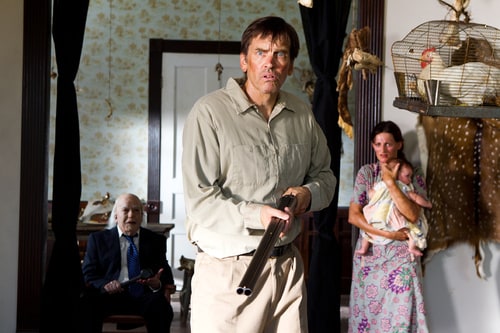It's hard to deny the importance or excellence of Tobe Hooper's 1974 classic The Texas Chainsaw Massacre, which has gone down in history as one of the most unforgettable horror films in history. With its raw disposition and 16mm photography, it remains a chilling film four decades on, which makes it all the more disappointing that none of its sequels or spinoffs have come close to equalling its unique brand of terror. Even Hooper's own sequel The Texas Chainsaw Massacre 2 is held in low regard, and the less said about the 2003 remake or its 2006 prequel, the better. And now into this overcrowded arena steps 2013's Texas Chainsaw 3D, which ignores all the other nonsense that has occurred since 1974 to emerge as a direct sequel to Hooper's movie. Directed by John Luessenhop (Takers), it's a movie that aspires to restart the series without another remake, rendering all the gore in glorious 3D this time. Unfortunately, the resulting picture is just one more awful Texas Chainsaw feature, showing yet again that Hooper's classic is untouchable.

After the events of the original movie, the local community are hungry for vengeance, descending upon the Sawyer Farmhouse with loaded guns and Molotov cocktails, burning the property to the ground and seemingly killing everyone inside. A baby survives the slaughter and is placed into the care of a redneck couple. 40 years later, the baby has grown into 20-year-old Heather (Alexandra Daddario), who learns of her true family heritage when she inherits her late grandmother's estate. She hits the road with pals Ryan (Trey Songz), Nikki (Tania Raymonde) and Kenny (Keram Malicki-Sánchez) to claim the place, collecting a hitchhiker (Shaun Sipos) during their travels. Arriving in the town of Newt, the group are given the keys to a lavish mansion, but it doesn't take long for Leatherface (Dan Yeager) to be unleashed from his prison in the basement. Suffice it to say, Leatherface does not appreciate the intrusion, and sets out to slaughter Heather and her companions.
To establish itself as a direct sequel to Hooper's original film, Texas Chainsaw 3D actually begins with clips from its predecessor (converted to 3D for good measure) before continuing right where the story left off. But then the picture suddenly jumps to 2013, even though it retains characters who've only aged about twenty years over the past four decades. Heather should in fact be a 40-year-old woman, while the cops involved in the incident (not to mention the mayor) should be retired and dead. As for Leatherface, he should be at least 65 or 70 years old and barely able to carry a chainsaw, let alone chase his victims. Perhaps this story might have worked if it was set in the 1990s, but instead, it's set in 2013 for no compelling reason, with police officers using their iPhones to make Skype calls while wandering through dangerous territory. And apparently Heather and her friends are the only young folks without iPhones, as they don't try to call for help while being stalked by Leatherface. How convenient.

Texas Chainsaw 3D is bone-headed beyond all belief, bouncing between the preposterous and the outright retarded. Heather and Leatherface eventually find out about their family connection and suddenly befriend each other due to tenuous blood ties, even though Leatherface slaughtered all of Heather's mates and should be committed to a mental asylum. Even a law-abiding cop is willing to let Leatherface return to his dungeon where he can kill again. By the time Heather begins enabling her cousin, all sense of rationality and logic has dried up. The entire subplot regarding the police is awful, and the screenplay involves some of the most laughably idiotic police behaviour in recent memory. Worse, all of the Leatherface showdowns are moronic, particularly a detour into a carnival during which the crowd seem very casual despite Leatherface running through them holding a roaring death machine, rampaging towards Heather. Texas Chainsaw 3D wants to replicate the terror of the 1974 movie with its string of pursuits and showdowns, but the rampant stupidity is astonishing, providing a hurdle that's impossible to overcome.
Admittedly, there is some entertainment to be had throughout the picture's second act, as the pace picks up and folks start getting slaughtered in gory ways. There's plenty of running and hiding going on, and Luessenhop delivers a great deal of graphic violence as one would expect from a Texas Chainsaw movie (although, curiously, no nudity). Even the twangy photograph sound effect from the 1974 picture makes a comeback. The gore effects are reasonably effective, and the movie looks polished enough, with 3D photography used to enhance the experience. At least it was filmed and planned in three dimensions, but there's absolutely no convincing reason to watch this dreck with the glasses on. Unfortunately, the acting across the board is pretty poor as well. Daddario is a very standard-order horror heroine, while most everyone else is flat.

Texas Chainsaw 3D could be called a disappointment, but it's on the same wavelength as the other stinkers that have followed the original classic since its 1974 release, so having raised hopes in the first place would be foolish. The dialogue is awful and the plot contortions are monumentally idiotic, not to mention the filmmakers make the ill-advised decision to turn the nefarious Leatherface into a misunderstood anti-hero who just hunts down bad men. Seriously? It's unclear exactly what those behind Texas Chainsaw 3D were thinking while assembling this turkey, but it's clear that concepts like logic and quality were ignored. It's not scary or terrifying, and the only pulse-quickening moments are cheap jump-scares that make no impact. Just stick with the original.
4.2/10
 Login
Login
 Home
Home 183 Lists
183 Lists 1667 Reviews
1667 Reviews Collections
Collections
 0 comments,
0 comments, 































